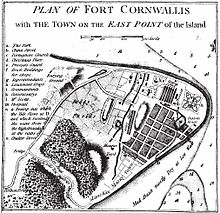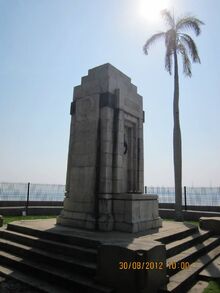
The Esplanade is located in the heart of George Town. On a clear day, the town of Butterworth on mainland Malay Peninsula can be seen in the horizon.
The Esplanade is the seaside promenade at the heart of George Town's UNESCO World Heritage Site. It was the first area to be cleared under Captain Francis Light, who first landed at the adjacent Fort Cornwallis. The area around the Esplanade can be regarded as George Town's civic centre; the Esplanade is surrounded by colonial administrative buildings, such as (from west to east) the Penang City Hall, the Town Hall, the Supreme Court of Penang, the State Assembly Building, the Jubilee Clock Tower and Fort Cornwallis.

The Padang at The Esplanade, George Town. The Town Hall (left) and the Penang City Hall (right) can be seen in the background.
The Esplanade includes the historical parade field, known as Padang Kota Lama or simply as the Padang in Malay. The urban planning of the Esplanade is therefore similar to the Padang in Singapore's Civic District. Initially used as a parade ground by the British East India Company, the Padang was utilised for cricket matches and public events. To this day, the Padang has been utilised for major events and celebrations.
The Esplanade is bounded by Light Street to the south and Jalan Tun Syed Sheh Barakbah to the west and to the east. The Esplanade Road separates the Padang on one side, and the City Hall and the Town Hall on the opposite side.
History[]

Fort Cornwallis and the Esplanade can be seen in this 1799 map of George Town.
Captain Francis Light first landed on Penang Island at what is now Fort Cornwallis, right next to the Padang. He then ordered the clearing of the jungles by firing silver dollars from his ship's cannons and encouraging immigrants with as much land as they can clear. The Esplanade was the first such area to be cleared.
As early as the 1800s, the Padang was used as the British East India Company's parade ground for the company's Indian sepoys (soldiers). It was also used to sort out Indian convict workers upon their arrival. The Padang at the time was completely shaded with trees.
In the 1860s, the 'Manila Band', a Filipino band employed by the Municipal Council of George Town, performed on the Municipal Band Stand at the southern end of the Padang. The bandstand had been donated by a local businessmen, Cheah Tek Soon. At the time, the rich and famous strolled on the boardwalks of the Esplanade, enjoying the sea breeze in the evenings while listening to the band's performances. Today, the Municipal Band Stand is long gone, replaced only recently with a Speakers' Square as a symbol of the freedom of expression under the new Penang state government, which consists of the Democratic Action Party (DAP) and the People's Justice Party (PKR).
Throughout the 19th. century and into the early 20th. century, colonial administrative buildings were completed around the Padang. Esplanade Road, which separates the City Hall and the Town Hall on one side and the Padang on the other, was created by the 1880s. The seafront road (now Jalan Tun Syed Sheh Barakbah) was known by two names, Fort Road (between the Jubilee Clock Tower and the bend at Fort Cornwallis) and The Esplanade (between the bend at Fort Cornwallis and Esplanade Road). Interestingly, The Esplanade is called Kuan1'a1 Kak3 (Checkpoint Corner) or Phak Kew Por (Playing Ball Field) in the Hokkien dialect.

The Municipal Fountain at the junction between Esplanade Road and Light Street was donated in 1883 by Koh Seang Tat, a local Chinese millionaire.
Meanwhile, the Municipal Fountain that now stands at the junction of Esplanade Road and Light Street was donated by Koh Seang Tat, a local 19th. century millionnaire, to the Municipal Council of George Town.
A cricket pavilion was built for the Penang Cricket Club in 1884 at the western side of the Esplanade, followed by another one for the Penang Recreation Club at the eastern side in 1890. The former was an European-only club, while the latter was only open to Eurasians. From then on, the Padang was used for sports matches such as cricket, football and, occasionally, rugby, depending on the season.

The Penang Cricket Club (now the Penang Sports Club) on the Padang. The clubhouse, along with several other structures on the Padang, was destroyed during World War 2.
In 1907, the government leased the Padang to the Penang Cricket Club on a 30-year lease. The club replaced their cricket pavilion the following year with a two-storey pavilion designed by Wilson and Neubronner. In the 1930s, the Penang Cricket Club was absorbed into the Penang Sports Club. In order to return the Padang to the public, the Penang Sports Club gave up the pavilion to be demolished in 1940. In a twist of fate, both cricket pavilions and a new structure housing the Eurasian Recreation Club were eventually destroyed by Japanese and Allied bombers during World War 2.
Also, during World War 2, the Japanese constructed military warehouses and a light rail-line on the Padang. Later, the Allied bombardments of George Town destroyed all structures within the Padang.

The Cenotaph at the Esplanade
The Cenotaph at the Esplanade was erected to commemorate the fallen Allied soldiers of World War 1. It, too, was destroyed by Allied bombers during World War 2. Rebuilt after the war at the cost of $3,500 (Malayan dollar), it looks slightly different from the original Cenotaph, as the remaining original granite blocks and bronze plaques had to be used. Nonetheless, the Cenotaph was ready in time for Remembrance Sunday, 11 November 1948. Every November 11, a Remembrance Sunday ceremony takes place at the Cenotaph, in honour of all Commonwealth servicemen who died defending Malaysia.

The Logan Memorial marks the junction between Light Street and Jalan Tun Syed Sheh Barakbah (The Esplanade).

Dewan Sri Pinang
The renaming of both The Esplanade and Fort Road into Jalan Tun Syed Sheh Barakbah in the 1970s also extended the Esplanade to the west, parralel to Green Hall and exiting towards Light Street. The junction between Jalan Tun Syed Sheh Barakbah and Light Street is now marked by the Logan Memorial, built after James Richardson Logan, a Scottish lawyer who defended the rights of non-Europeans in colonial Penang. A multi-purpose auditorium, the Dewan Sri Pinang, was subsequently built here.
The trees around the Padang were planted by several dignitaries, such as the then Japanese Crown Prince Akihito, the then Mayors of Adelaide, Steve Condous and James Jarvis, and the then District Head of Medan, A.S. Rangkuty.

The suburb of Tanjung Tokong to the west can be seen from the Esplanade.
Since independence in 1957, the Padang has been used for election rallies due to its central location. Even Singapore's first Prime Minister, Lee Kuan Yew, campaigned here when the People's Action Party (PAP), Singapore's ruling party, decided to campaign in Peninsular Malaysia for the 1964 Malaysian General Elections. More recently, in 2008 and 2013, the DAP and the PKR drew massive crowds numbering tens of thousands in their rallies on the Padang.
Today, the Esplanade is a famous promenade amongst tourists and local Penangites alike. The Padang remains a venue of choice for major celebrations and events involving the Penang state government.
Attractions[]

A German Heritage Trail signboard at the Esplanade, which commemorates the contributions of the German merchant community in George Town during the colonial era.

The Cenotaph, with the Penang City Hall along Esplanade Road at the background.

The Millennium Monument was built by the ruling Barisan Nasional coalition in 2000 despite criticism from local Penangites.
- The German Heritage Trail commemorates the contributions of the small German trading community in George Town.
- The Cenotaph was built in honour of the dead Allied soldiers of World War 1.
- The controversial Millennium Monument was completed in 2000.
- The trees around the Padang were planted by local and foreign dignitaries, including the then Japanese Crown Prince Akihito, the then Mayors of Adelaide, Steve Condous and James Jarvis, and the then District Head of Medan, A.S. Rangkuty.
Food[]

The Esplanade Park hawker centre
There are two hawker centres at either side of the Esplanade.
- Kompleks Makanan Medan Renong Padang Kota Lama at the western end of the Esplanade.
- The Esplanade Park at the eastern end of the Padang, next to Fort Cornwallis's western entrance.
Political Representation[]
Penang State Government[]
N.26 Padang Kota State Assemblyman : Chow Kon Yeow (Democratic Action Party)
Malaysian Federal Parliament[]
P.049 Tanjong Member of Parliament : Ng Wei Aik (Democratic Action Party)
References[]
- Hockton, K., Howard Tan, 2012. Penang : An Inside Guide to Its Historic Homes, Buildings, Monuments and Parks. MPH Group, Kuala Lumpur.
- Langdon, M. A Guide to George Town's Historic Commercial and Civic Precints. Penang : George Town World Heritage Incorporated.
- http://www.penang-traveltips.com/esplanade.htm
- http://www.penang-traveltips.com/padang-kota-lama.htm
- http://www.penang-traveltips.com/speakers-square.htm
- http://www.penang-traveltips.com/millennium-monument.htm
- http://www.penang-traveltips.com/trees-of-the-esplanade.htm
- http://www.penang-traveltips.com/esplanade-road.htm
- http://www.penang-traveltips.com/jalan-tun-syed-sheh-barakbah.htm
- http://www.nas.gov.sg/archivesonline/data/pdfdoc/lky19640420.pdf